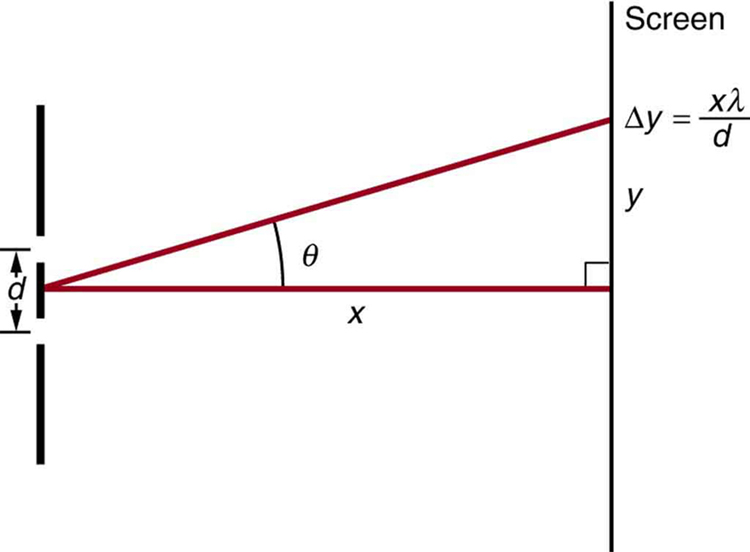| << Chapter < Page | Chapter >> Page > |
Suppose a feather appears green but has no green pigment. Explain in terms of diffraction.
It is possible that there is no minimum in the interference pattern of a single slit. Explain why. Is the same true of double slits and diffraction gratings?
A diffraction grating has 2000 lines per centimeter. At what angle will the first-order maximum be for 520-nm-wavelength green light?
Find the angle for the third-order maximum for 580-nm-wavelength yellow light falling on a diffraction grating having 1500 lines per centimeter.
How many lines per centimeter are there on a diffraction grating that gives a first-order maximum for 470-nm blue light at an angle of ?
What is the distance between lines on a diffraction grating that produces a second-order maximum for 760-nm red light at an angle of ?
Calculate the wavelength of light that has its second-order maximum at when falling on a diffraction grating that has 5000 lines per centimeter.
707 nm
An electric current through hydrogen gas produces several distinct wavelengths of visible light. What are the wavelengths of the hydrogen spectrum, if they form first-order maxima at angles of , , , and when projected on a diffraction grating having 10,000 lines per centimeter? Explicitly show how you follow the steps in Problem-Solving Strategies for Wave Optics
(a) What do the four angles in the above problem become if a 5000-line-per-centimeter diffraction grating is used? (b) Using this grating, what would the angles be for the second-order maxima? (c) Discuss the relationship between integral reductions in lines per centimeter and the new angles of various order maxima.
(c) Decreasing thenumber oflines percentimeter bya factorof x meansthat theangle forthe x‐ordermaximum isthe sameas theoriginal anglefor thefirst- ordermaximum.
What is the maximum number of lines per centimeter a diffraction grating can have and produce a complete first-order spectrum for visible light?
The yellow light from a sodium vapor lamp seems to be of pure wavelength, but it produces two first-order maxima at and when projected on a 10,000 line per centimeter diffraction grating. What are the two wavelengths to an accuracy of 0.1 nm?
589.1 nm and 589.6 nm
What is the spacing between structures in a feather that acts as a reflection grating, given that they produce a first-order maximum for 525-nm light at a angle?
Structures on a bird feather act like a reflection grating having 8000 lines per centimeter. What is the angle of the first-order maximum for 600-nm light?
An opal such as that shown in [link] acts like a reflection grating with rows separated by about . If the opal is illuminated normally, (a) at what angle will red light be seen and (b) at what angle will blue light be seen?
At what angle does a diffraction grating produces a second-order maximum for light having a first-order maximum at ?
Show that a diffraction grating cannot produce a second-order maximum for a given wavelength of light unless the first-order maximum is at an angle less than .
If a diffraction grating produces a first-order maximum for the shortest wavelength of visible light at , at what angle will the first-order maximum be for the longest wavelength of visible light?
(a) Find the maximum number of lines per centimeter a diffraction grating can have and produce a maximum for the smallest wavelength of visible light. (b) Would such a grating be useful for ultraviolet spectra? (c) For infrared spectra?
(a) Show that a 30,000-line-per-centimeter grating will not produce a maximum for visible light. (b) What is the longest wavelength for which it does produce a first-order maximum? (c) What is the greatest number of lines per centimeter a diffraction grating can have and produce a complete second-order spectrum for visible light?
(a) The longest wavelength is 333.3 nm, which is not visible.
(b) 333 nm (UV)
(c)
A He–Ne laser beam is reflected from the surface of a CD onto a wall. The brightest spot is the reflected beam at an angle equal to the angle of incidence. However, fringes are also observed. If the wall is 1.50 m from the CD, and the first fringe is 0.600 m from the central maximum, what is the spacing of grooves on the CD?
The analysis shown in the figure below also applies to diffraction gratings with lines separated by a distance . What is the distance between fringes produced by a diffraction grating having 125 lines per centimeter for 600-nm light, if the screen is 1.50 m away?

Unreasonable Results
Red light of wavelength of 700 nm falls on a double slit separated by 400 nm. (a) At what angle is the first-order maximum in the diffraction pattern? (b) What is unreasonable about this result? (c) Which assumptions are unreasonable or inconsistent?
Unreasonable Results
(a) What visible wavelength has its fourth-order maximum at an angle of when projected on a 25,000-line-per-centimeter diffraction grating? (b) What is unreasonable about this result? (c) Which assumptions are unreasonable or inconsistent?
(a) 42.3 nm
(b) Not a visible wavelength
The numberof slitsin thisdiffraction gratingis toolarge. Etchingin integratedcircuits canbe doneto aresolution of50 nm,so slitseparations of400 nmare atthe limitof whatwe cando today.This linespacing istoo smallto producediffraction oflight.
Construct Your Own Problem
Consider a spectrometer based on a diffraction grating. Construct a problem in which you calculate the distance between two wavelengths of electromagnetic radiation in your spectrometer. Among the things to be considered are the wavelengths you wish to be able to distinguish, the number of lines per meter on the diffraction grating, and the distance from the grating to the screen or detector. Discuss the practicality of the device in terms of being able to discern between wavelengths of interest.

Notification Switch
Would you like to follow the 'College physics for ap® courses' conversation and receive update notifications?